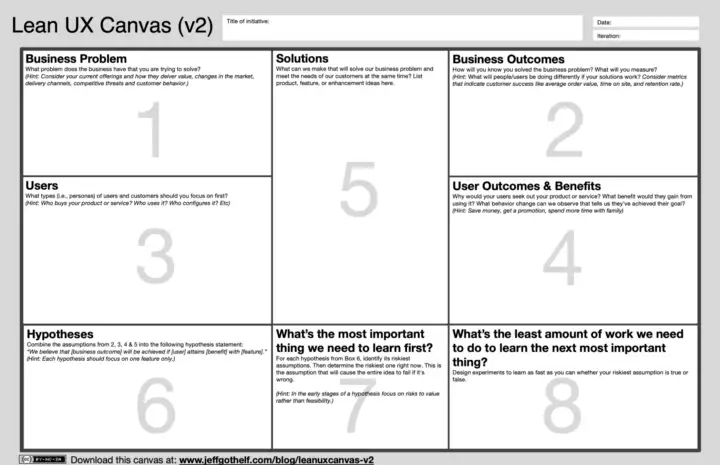My personal experience of using the Lean UX Canvas for the first time in a new SAFe based Agile environment with a cross-functional team and a complex product.
The Lean UX Canvas was a great answer to align a cross-functional team for a complex product. The canvas allowed us to have a customer-centric conversation and focus on the ‘why’. In other words, it was a great step to get out of the “deliverables” business, and focus on outcomes rather than outputs.
The problem
The initial request was to create output for an MVP on the commercial website to show this brand new product to the customer. The problem though, is that it’s a complex product on different layers such as integration, intention and environment. Therefore, designing an MVP, with no clear goals and context in mind, would be a recipe to see it get stretched and stretched by endless debate. And like most projects, it comes with a deadline.
Instead of focussing on creating output for the MVP as soon as possible, it made more sense to dive into a workshop to align on outcomes. Since we work in a new developing Agile environment, a Lean UX approach could provide clear answers to what we were looking for.
Trail & tribulation
Stakeholder interviews to build rapport
The Lean & Agile maturity in the company is growing, we had to wait a little while to get stakeholders with cross-functional roles and teams together. Therefore we planned some stakeholder interviews to listen to a few key stakeholders to learn about their responsibilities, roles, concerns, and frustrations.
One of the main advantages of working in an Agile environment is that you can pivot when needed. So exposing yourself during these ‘waiting periods’ can clarify how you should proceed with the project. In addition, listening to your key stakeholders is a great way to build rapport and to get them excited about a Lean UX Canvas workshop.
Facilitating a cross-functional team
Facilitating a Lean UX Canvas workshop was a first for me and the participants. Luckily, is the canvas easy to explain. There are eight boxes, each with a clear goal in mind.

In reading the latest edition of Jeff Gothelf’s and Josh Seiden’s Lean UX book, it was quite obvious that there is a big difference between filling in the boxes with a mature team, and facilitating the canvas for a cross-functional team with niche specialists trying to get a customer-focused conversation about business and user problems and outcomes.
To make this workshop a success, I studied a large part of the Lean UX book. There are a few approaches in the book that I have facilitated before, so that experience came in handy. But since a Lean and Agile mindset doesn’t fit into superheroes or ninjas, it’s OK to be transparent. So I explained this to them at the very beginning of the workshop, using the book along the way.
The result
The profit
Despite it being our first time and that only 3 hours could be freed up, the first 4 boxes did exactly what they were supposed to do: start a conversation about business and user outcomes rather than outputs. Having the chance to conduct a Lean UX method, even though only partially completed, was a win for the entire team. The team was aligned on business and user outcomes, and what sounded like rocket science before became much more clear and digestible.
The loss
Unfortunately, getting the whole team back together would take too much time to proceed. Since the company is still growing in a cross-functional Agile environment it’s not easy to block a half a day of people’s agendas in the same week or even upcoming weeks. Therefore, our team decided to move forward without the Lean UX Canvas’ solutions, hypotheses, and experiments. But to continue with a more Waterfall-like discovery phase in which I, rather than the team, decide what needs to be researched, built and tested, one iteration at a time.
Conclusion
Nonetheless, I see the Lean UX Canvas as a success. I approach the growing Agile and Lean maturity in the company (SAFe framework based) like an onion, trying to peel off one or a few layers each time. For the team, which I am working with for this project, aligning with business and user issues and outcomes is an achievement in itself. The next step would be to involve them in user research and concept design to show how important it is to think about the right solutions, hypotheses and experiments. So that next time the cross-functional team will seethe value of getting involved in the Lean UX Canvas until we have a user-centric product, tested one experiment at a time.